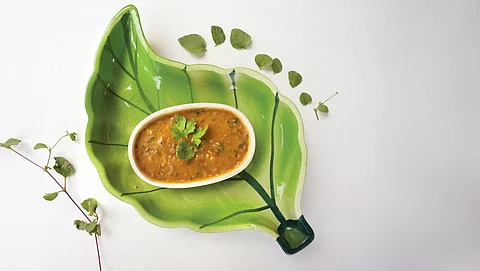

Punarnava, which once adorned the sidewalks of Delhi, is now rare to spot in the city’s concretised landscape. So, I was elated at the sight of the creeper on the campus of Indian Agricultural Research Institute in Delhi. Despite this year’s harsh summer, it was growing profusely around a tube well that remained shaded by trees. It is said that the plant can regrow even from a sprig. Probably this is the reason, it has been named punarnava, which in Sanskrit means renewal and rejuvenation.
A review paper in Canadian Journal of Botany published in 1979, has references that suggest that the plant derives its name from the Sanskrit phrase “Punah punarnava bhawati iti”, which captures its perennial habit. It remains dry and dormant during summer and regenerates from the old root stock in the rainy season. The name could also have arisen from the phrase, “Karoti shariram punarnavam”, which can be loosely translated as “the one that rejuvenates the body” and indicates its therapeutic value.
The plant has two variants—one with white flowers and the other with red flowers. According to a 2016 study published in International Journal of Ayurveda and Pharma Research, these variants are distinct species. The one with white flowers is Boerhaavia verticillata, whereas the one with red flowers is classified as Boerhaavia diffusa. However, in ayurveda both the species are referred to as punarnava and are regarded to have therapeutic properties.
Researchers from Sri Ganganagar College of Ayurvedic Science and Hospital in Rajasthan have reviewed scientific studies available on the plant. They say the plant is widely distributed in the tropical and subtropical regions. In India, it is found throughout the warmer regions and has even been recorded at an elevation of 2,000 metres in the Himalayas. The paper, published in World Journal of Pharmaceutical and Medical Research in 2022, states that the plant, whose fleshy leaves are slightly bitter in taste, is part of people’s diet in many parts of India.
In Purulia district of West Bengal, tribal communities consume this plant as a leafy green. In Assam, the demand for punarnava is so high that the leaves can be found being sold in local markets. Addition of the leaves to dal, chutney or a sabji can give the food a healthy twist (see recipe).
The review paper published in Canadian Journal of Botany also documents the traditional importance of the plant for several tribal communities. The inhabitants of the Garhwal Himalayas use the roots in the treatment of piles. In Madhya Pradesh, the Bhil community uses the paste made from punarnava to treat bloody dysentery, while the tribal communities in Ambikapur district use it for treating elephantiasis.
In Odisha’s Kandhamal district, the Kandha tribal community use the paste made from the whole plant to treat snake bites. Using the paste made from punarnava leaves to treat wounds is common among the Sahariya tribe in central India, according to a study published in the African Journal of Traditional and Complementary and Alternative Medicine in 2011. In Madhya Pradesh, tribal communities in Guna district use punarnava as a diuratic and for treating urinary problems and jaundice, states a 2020 study published in International Journal of Advance Scientific Research and Engineering Trends.
In ayurvedic medicine, punarnava is used in rasayana shastra—one of the eight areas of medicine. Bhavprakash Nighantu, a literature on ayurvedic medicine written in the 16th century AD, prescribes the plant with white flowers in case of pandu (anaemia), shotha (inflammation), udarroga (abdominal disorders) and for the elimination of vayu (flatus), vish (toxins) and kapha (phlegm). The plant with red flowers is given in case of eye disorders such as cataract. Fresh as well as dried plant parts of Boerhaavia diffusa is a source of the drug punarnava, which has a place in Ayurvedic Pharmacopoeia of India, a book of standards under the Drugs and Cosmetic Act 1940. The leaves and roots are also used in homeopathy to improve digestion, alleviate fluid retention and manage heart diseases.
Recent scientific studies have also found that punarnava is rich in several bioactive compounds that impart therapeutic properties to the plant. These include phenolics, rotenoids and flavonoids, states a 2023 study published online in Frontiers in Chemistry. To experience the benefits, all that one has to do is find a twig of punarnava and plant it.
Ingredients
Punarnava leaves: 1 large bowl
Masoor dal (red split lentils): 1 cup
Onion (medium sized): 1 (diced)
Tomatoes (medium-sized): 2
Green chillies: 2; red chilli: 1
Oil: 2 tablespoon
Mustard seeds: 1/4 teaspoon
Cumin seeds: 1/4 teaspoon
Urad dal (black gram): 1/2 tbsp
Chana dal (Bengal gram): 1/2 tbsp
Curry Leaves: a few sprigs
Coriander seeds: 1 tsp
Turmeric powder: 1/2 tsp
Red chilly powder: 1/2 tsp
Garam masala: 1/2 tsp
Ginger: small piece
Garlic: 3 cloves
Tamarind: 10 gram
Salt to taste
Method
Wash the leaves; chop them into small pieces. Wash dal; soak for 30 minutes. Pressure cook the dal with turmeric powder and punarnava leaves; mash well. Heat oil in a pan. Add mustard seeds, cumin seeds, urad dal, chana dal and saute for a couple of minutes. Add onion and red chillies and saute again, for 3-4 minutes. Add ginger and garlic paste; saute until the raw smell goes away. Add tomatoes; cook until soft. Add garam masala, red chilli powder and salt. Saute for 1 minute. Add tamarind pulp and boil for 2 minutes. Then add mashed dal and punarnava leaves. Mix well, add water if required and boil for 3-5 minutes.
This was first published in the 1-15 November, 2024 print edition of Down To Earth